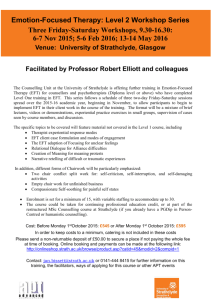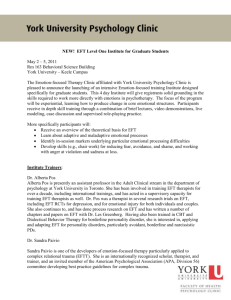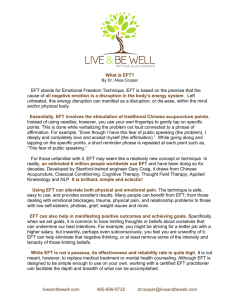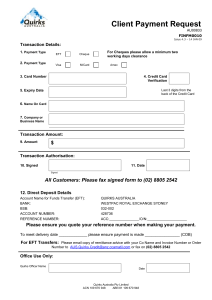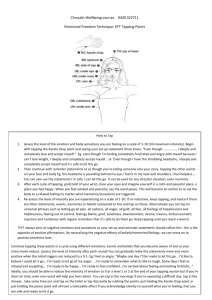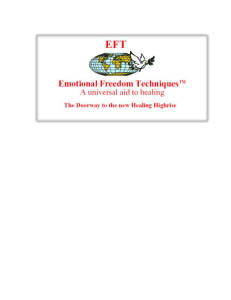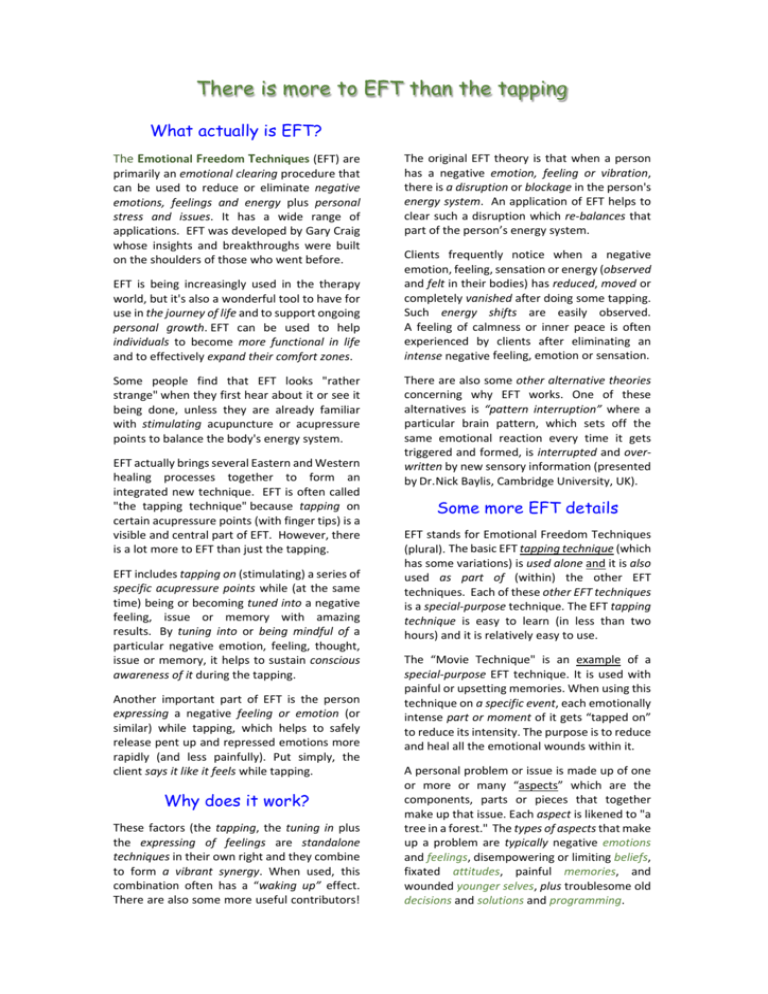
There is more to EFT than the tapping
What actually is EFT?
The Emotional Freedom Techniques (EFT) are primarily an emotional clearing procedure that can be used to reduce or eliminate negative emotions, feelings and energy plus personal stress and issues. It has a wide range of applications. EFT was developed by Gary Craig whose insights and breakthroughs were built on the shoulders of those who went before. The original EFT theory is that when a person has a negative emotion, feeling or vibration, there is a disruption or blockage in the person's energy system. An application of EFT helps to clear such a disruption which re‐balances that part of the person’s energy system. EFT is being increasingly used in the therapy world, but it's also a wonderful tool to have for use in the journey of life and to support ongoing personal growth. EFT can be used to help individuals to become more functional in life and to effectively expand their comfort zones. Clients frequently notice when a negative emotion, feeling, sensation or energy (observed and felt in their bodies) has reduced, moved or completely vanished after doing some tapping. Such energy shifts are easily observed. A feeling of calmness or inner peace is often experienced by clients after eliminating an intense negative feeling, emotion or sensation. Some people find that EFT looks "rather strange" when they first hear about it or see it being done, unless they are already familiar with stimulating acupuncture or acupressure points to balance the body's energy system. There are also some other alternative theories concerning why EFT works. One of these alternatives is “pattern interruption” where a particular brain pattern, which sets off the same emotional reaction every time it gets triggered and formed, is interrupted and over‐
written by new sensory information (presented by Dr. Nick Baylis, Cambridge University, UK). EFT actually brings several Eastern and Western healing processes together to form an integrated new technique. EFT is often called "the tapping technique" because tapping on certain acupressure points (with finger tips) is a visible and central part of EFT. However, there is a lot more to EFT than just the tapping. EFT includes tapping on (stimulating) a series of specific acupressure points while (at the same time) being or becoming tuned into a negative feeling, issue or memory with amazing results. By tuning into or being mindful of a particular negative emotion, feeling, thought, issue or memory, it helps to sustain conscious awareness of it during the tapping. Another important part of EFT is the person expressing a negative feeling or emotion (or similar) while tapping, which helps to safely release pent up and repressed emotions more rapidly (and less painfully). Put simply, the client says it like it feels while tapping. Why does it work?
These factors (the tapping, the tuning in plus the expressing of feelings are standalone techniques in their own right and they combine to form a vibrant synergy. When used, this combination often has a “waking up” effect. There are also some more useful contributors! Some more EFT details
EFT stands for Emotional Freedom Techniques (plural). The basic EFT tapping technique (which has some variations) is used alone and it is also used as part of (within) the other EFT techniques. Each of these other EFT techniques is a special‐purpose technique. The EFT tapping technique is easy to learn (in less than two hours) and it is relatively easy to use. The “Movie Technique" is an example of a special‐purpose EFT technique. It is used with painful or upsetting memories. When using this technique on a specific event, each emotionally intense part or moment of it gets “tapped on” to reduce its intensity. The purpose is to reduce and heal all the emotional wounds within it. A personal problem or issue is made up of one or more or many “aspects” which are the components, parts or pieces that together make up that issue. Each aspect is likened to "a tree in a forest." The types of aspects that make up a problem are typically negative emotions and feelings, disempowering or limiting beliefs, fixated attitudes, painful memories, and wounded younger selves, plus troublesome old decisions and solutions and programming. Some problems or issues are more complex than others, with some being multi‐layered (like an onion) and built up over the years. EFT practitioners and therapists understand aspects and use proven strategies to separate them out so they can then work more effectively on more specific aspects. They systematically work with their clients to locate and eliminate the key aspects of their problems. Some issues are not very complex at all even though they’ve existed for many years. The abbreviation "EP" on this web site refers to Energy Psychology and EFT is the most scientifically studied of the "energy techniques" that come under this heading. This is exciting times for EFT practitioners and trainers. Most of these studies have been carried out in a therapeutic context, but EFT also has a wide range of other uses and applications (including for lay practitioners and those who only want to self‐apply it or to enhance performance). Hundreds of thousands of people around the world have found EFT to be useful for reducing stress, expanding comfort zones, freeing up fixated attention, enhancing performances, healing relationship wounds, resolving underlying emotional issues that are contributing to or causing physical dis‐eases or discomforts, becoming more able to accept “what is” (reality), and facilitating ongoing personal and spiritual growth. An important skill of an EFT practitioner is determining or selecting what to focus and tap on at various times during a session. There can sometimes be a number of options. Practitioners mostly tap on what is manifesting now and thus work with what the subconscious mind is currently bringing up. When an aspect has been resolved, another aspect often spontaneously manifests (which can then be tapped on next). Almost anyone can learn the simple EFT tapping technique and then self‐apply it, using it as a tool to reduce the intensity of current stresses and emotions that pop up in the (sometimes, bumpy) journey of life. The EFT tapping technique can be learnt and used immediately. If you choose to, you can gradually develop your skills further by expanding your “EFT toolkit” and continuing to grow with it. Testing is a required and important part of EFT. The intensity of a current emotion, feeling or some another aspect is established (“0 to 10?”) before tapping and then checked again after it has been “tapped on” to see if it’s reduced. The tapping (and maybe some changes) is then continued to lower the intensity further. The aim is zero. This down‐to‐earth thoroughness is standard EFT practice. EFT isn’t always fast. There can be issues and aspects where persistence is required before shifts or changes take place. Sometimes, a subconscious resistance and/or a “benefit” can be blocking progress. A problem may need to be approached from different angles before an “entrance point” can be found. These are “business as usual” for experienced EFT practitioners, coaches and therapists. An introductory EFT workshop is available that teaches EFT basics so that the EFT tapping technique can be easily used or self‐applied. There are also more advanced EFT trainings for EFT practitioners and coaches, health care professionals, complementary therapists, and also anyone enthused by EFT. The article “What is EFT?” by EFT Founding Master Judy Byrne introduces EFT and its origins (http://eftmastersworldwide.com/what‐is‐
eft/). And, my article “Why is EFT so Effective?” (in www.tap4peace.com.au) provides a more detailed examination and overview of why EFT works so effectively and also describes some additional (but less obvious) contributors. The success of an EFT session doesn’t entirely depend on the practitioner. It also requires client participation. A successful session is a team activity where the practitioner and client work closely together. A useful viewpoint is that the client is not a problem, he/she has a problem. The EFT practitioner’s role is mainly to facilitate, guide, support and encourage the client during the sessions to help him or her connect with and activate one or more relevant natural healing processes. NOTICE: This document may be passed on or freely
copied or printed in full or shared providing that it is not
altered at all or subtracted from or added to in any way
and includes this notice plus the author’s name, date,
the copyright notice, and my web site (below).
What proof is there?
Peter Graham, certified EFT Founding Master
The effectiveness of EFT has been validated around the world by dozens of scientific studies (www.energypsych.org/?Research_Landing). 20th of Sept. 2012. Revised: 29th of Feb. 2016
My web page: www.tap4peace.com.au
Copyright © 2012 and 2016 by Peter D. Graham. All rights reserved.
2

